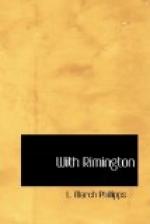The hills look peaceful enough now. The children press their noses and little india-rubber fingers against the glass, and chatter and laugh and bob up and down—
“Little they think of
those strong limbs
That moulder deep below.”
And I sit back in my corner ashamed of my dirty old tunic and the holes in it, and peer between two small flaxen heads at hills I last saw alive with bursting shell.
At Modder village I hired a horse and rode across the plain to Magersfontein. I must often have described the place to you—the great flat and the beak of hill, like a battleship’s ram, thrust southward into it. Do you know, I felt quite awestruck as I approached it. It seemed quite impossible that I, alone on my pony, could be going to ride up to and take single-handed that redoubtable hill, which had flung back the Highlanders, and remained impregnable to all our shelling. I thought some Boer, or ghost of a Boer, would pop up with his Mauser to defend the familiar position once more. However, none did. I picked my way through the trench, littered with scraps of clothing and sacks and blankets, with tins and cooking things, and broken bottles and all sorts of rags and debris littered about. The descriptions of the place sent home after the battle are necessarily very inaccurate. Those I have seen all introduce several lines of trenches and an elaborate system of barbed wire entanglements. There is only one trench, however, and no barbed wire, except one fence along a road. There are, however, a great number of plain wire strands, about ten yards long perhaps, made fast between bushes and trees, and left dangling, say, a foot from the ground. They were not laid in line, but dotted about in every direction, and, in anything like a dim light, would infallibly trip an advancing enemy up in all directions. The single trench is about five feet deep, the back of it undercut so as to allow the defenders to sleep in good shelter, and the number of old blankets and shawls lying here showed it had been used for this. It followed closely the contour of the hill, about twenty yards from its base. Eastward it was continued across the flat to the river.
The “disappearing guns,” in the same way, were not disappearing at all. They simply had strong redoubts of sandbags built round them, the opening in front being partly concealed by bushes. On each side of the gun, inside the redoubt, was a pit, with a little side passage or tunnel, where two or three gunners could lie in perfect security, and yet be ready at an instant’s notice to serve their gun. As for the kopjes themselves, every rock and stone there was split with shell and starred with bullet marks. The reverse side of the slopes were steepened with stone walls here and there, as a protection against shrapnel, and sangars and lookout places were built at points of vantage. Altogether, though not so elaborate as one had been led to believe, the defences struck one as extremely practical and business-like.




